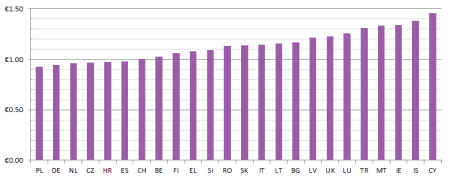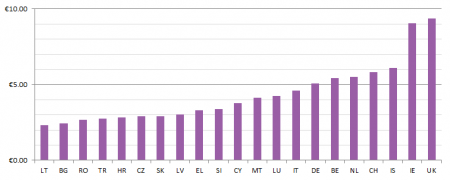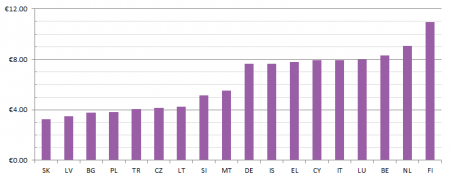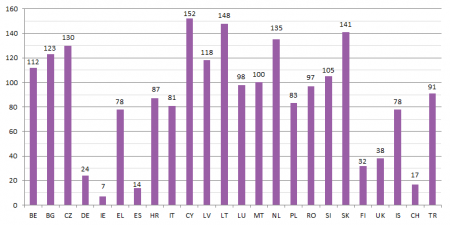Archive:Consumer prices - detailed average prices
- Data from 2012. Most recent data: Further Eurostat information, Main tables and Database.
Detailed price statistics and detailed price level data are needed for several purposes, including for product market and sector monitoring with a view to the improved monitoring of Single Market policies, and the understanding of how markets work.
Eurostat and the National Statistical Institutes are continuously investigating possibilities to extend the system of price statistics, and the project on Detailed Average Prices (DAP) aims to supplement existing consumer price statistics by providing indicative average prices for specific consumer goods and services across Europe.
Main statistical findings
Generally, some disparities should be expected between prices of the same product across countries. Reasons why are numerous, like; different excise duties and Value Added Tax (VAT); national production conditions where no cross-border trade is significant; exchange rates where relevant. But, among the 156 products surveyed in 2012 in the context of the DAP project, a few products had quite similar prices across Europe. One example is white sugar (1 kg fine, granulated), surveyed in 24 countries. Poland had the lowest average price (0.92 €/kg) while Cyprus showed the highest price (1.46 €/kg). This gives a maximum/minimum price ratio of 1.6.
Cigarettes (20 pack, filter) were surveyed in 21 countries. The lowest average price was observed in Lithuania, with a price of 2.32 € per cigarette pack. Six other countries had prices below 3 €/pack. On the other end of the scale was Ireland and the United Kingdom, with average prices above 9 €/pack. The maximum/minimum price ratio is 4.0. It should be noticed that tobacco prices in many countries are strongly influenced by governments through excise duties and taxes or the direct setting of a minimum price.
Cinema tickets (1 ticket, Saturday evening) were surveyed in 18 countries. The lowest average price was recorded for Slovakia, with a price of 3.27 €/ticket. Eight other countries, all Eastern European countries and Malta, had prices below 6 €/ticket. The maximum average price was for Finland (10.93 €/ticket). Eight other countries had prices around 8 €/ticket. The maximum/minimum price ratio is 3.3.
The price of a cup of coffee (served at the table with service charge) was surveyed in 21 countries. Bulgaria had the lowest average price (0.54 €/cup) and six other countries had prices below 1 €/cup. At the opposite end was Switzerland, where a serving of a cup of coffee on average is priced at 3.29 €/cup. The maximum/minimum price ratio is 6.1.
Data sources and availability
The first DAP project was run in 2008 and further pilot projects have been carried out annually. For the reference year 2012, indicative average prices of specific consumer goods and services from 24 countries are published in Eurobase. Sampling and data collection are carried out by National Statistical Institutes (NSIs). The product sample is determined in collaboration between the participant countries and Eurostat. The data source is chosen by NSIs. Some NSIs use the existing HICP data set which primary purpose is to measure price changes, other countries have developed a separate survey.
Context
All findings should be considered with care since the available average prices are indicative within the scope of the definitions used. They do not represent official national average prices (see Context and Limitations). Neither EU/EA nor product aggregates are published. Factors that influence price differences and limit the comparability of the results:
- One product cannot represent the full market in all countries for the consumption segments concerned. And even when products are identical across countries, they may not have the same relevance for the consumers in the various countries. For example the average price of a loaf of white bread may not be indicative of the price level of bread in general in a given country. The positions of the selected products on national markets may differ as well across countries even within the limits of the product specification.
- The outlet structure and distribution across countries are surely different. For example price differences across countries for ice-cream could be related to differences in market and outlet structure (locally produced or sold in supermarkets).
- The national samples may cover only prices for some types of brands, which can be chosen differently across countries. And even within the boundaries of the product specifications, quality differences may exist to a varying degree.
- In every Member State, the products have been selected following the procedures of the respective NSI. Additionally, the NSI is responsible for computing the average, using in many cases an unweighted arithmetic average of the price observations. In other countries regional price observations are weighed using regional population figures.
- The prices may be influenced by short term fluctuations in exchange rates. The impact depends on whether products were imported or produced locally, the tradability of products and other reasons.
See also
Further Eurostat information
Database
- Detailed average prices (prc_dap)
Dedicated section
Methodology / Metadata
Other information
- Harmonised indices of consumer prices (HICP) (prc_hicp)
- Purchasing power parities (prc_ppp)
External links
- European Commission - Directorate General for Health and Consumers (DG SANCO) - Consumer Markets Scoreboard
Notes



